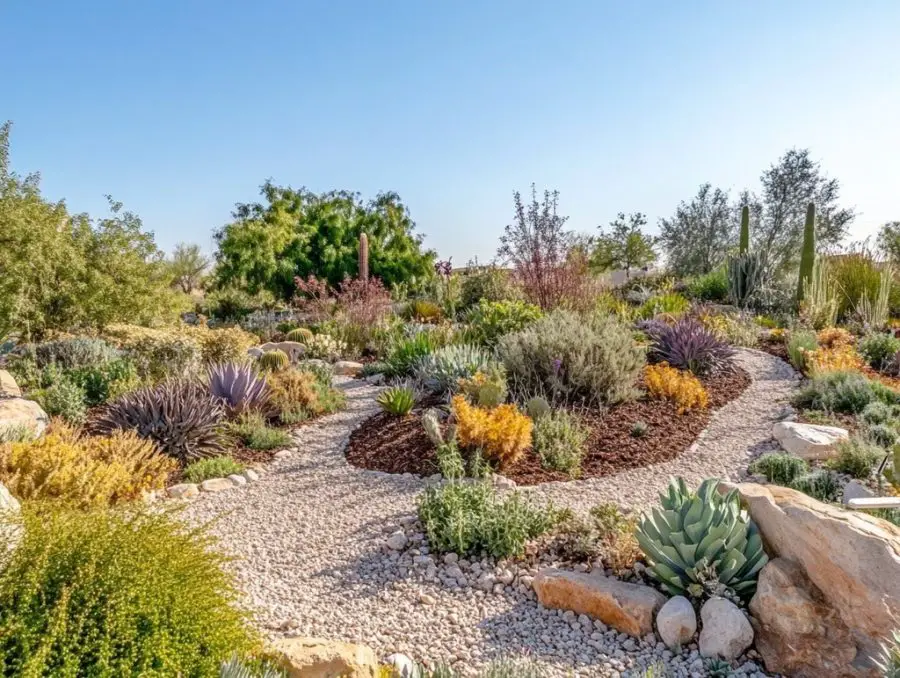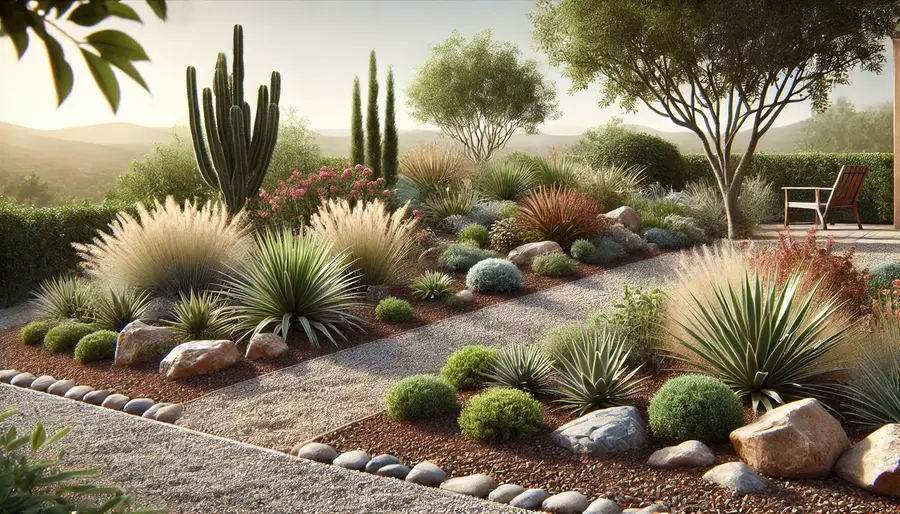We use affiliate links. If you purchase something using one of these links, we may receive compensation or commission.

Xeriscaping success tips for beginners can make all the difference when you’re starting out.
Many people dive in without a plan, only to end up frustrated with plants that struggle and landscapes that don’t hold up.
The good news? With the right approach like choosing the best plants, setting up efficient watering, and using smart design you’ll create a thriving, low-maintenance yard that saves water and looks amazing.
Xeriscaping Success Tips
Key Takeaways
- Xeriscaping success tips start with choosing drought-tolerant plants.
- Improving soil for water retention, and using drip irrigation to maximize efficiency.
- Mulching helps prevent weeds and keeps moisture in the soil.
- Incorporating hardscaping reduces maintenance and enhances design.
- With proper planning, your xeriscape will thrive with minimal effort.
Xeriscaping Success Tips for Beginners: A Must-Read Guide
Xeriscaping is a smart way to create a beautiful outdoor space while saving water and cutting down on maintenance.
If you’re new to this approach, getting started the right way can make all the difference.
In this guide, you’ll learn essential tips to design a thriving xeriscape, choose the best plants, and keep it looking great for years to come.
What is Xeriscaping and How Does it Work?
Xeriscaping is a smart way to create a beautiful outdoor space while using far less water than traditional landscaping.
It focuses on drought-tolerant plants, efficient irrigation, and soil improvements to keep everything thriving with minimal upkeep.
Whether you’re new to it or just looking to fine-tune your approach, understanding the basics is the first step to success!
Overview of Xeriscaping Principles
Xeriscaping is all about creating a water-efficient landscape that thrives in dry conditions.
It’s not just about using rocks and cacti. It’s about smart planning, grouping plants by their water needs, and improving soil to hold moisture.
The goal is to reduce reliance on irrigation while keeping your yard vibrant year-round.
Key principles include:
✅ Using drought-tolerant and native plants
✅ Improving soil to retain moisture
✅ Efficient irrigation methods like drip systems
✅ Mulching to reduce evaporation and weeds
✅ Incorporating hardscaping to minimize plant coverage
Why Beginners Should Consider This Approach
Xeriscaping is a game changer, especially if you want a great-looking yard without spending hours watering and maintaining it.
It helps cut water bills, reduces weeds, and eliminates the hassle of constant upkeep.
Plus, by choosing native plants, you’re creating a habitat that supports pollinators and local wildlife.
Essential Tips for Xeriscaping Success
Start with a Solid Design Plan
Before you start planting, take time to plan your xeriscape. A well-thought-out layout ensures everything thrives with minimal effort.
✅ Sketch Your Layout: Outline where you want plants, pathways, and hardscaping features. Keep in mind sunlight exposure and natural water flow.
✅ Group Plants by Water Needs: Place drought-tolerant plants together and keep slightly higher-water plants in one area to simplify irrigation.
✅ Consider Shade and Wind: Position taller plants and trees strategically to block wind and provide natural shade for smaller plants.
Choose Native and Drought-Tolerant Plants
Picking the right plants makes all the difference in xeriscaping.
Native species are naturally suited to your climate, making them easier to maintain and more resilient in dry conditions.
Why Native Plants Thrive in Xeriscapes:
- They’re adapted to local weather patterns.
- Require little to no additional watering once established.
- Support local pollinators like bees and butterflies.
Easy-to-Care-for Plants for Beginners:
- Agave – Striking appearance, extremely low maintenance.
- Lavender – Drought-tolerant with a pleasant scent.
- Yarrow – Tough, colorful, and thrives with little water.
- Sedum – Great for ground cover and needs minimal care.
Optimize Your Soil for Water Retention
Healthy soil is key to a thriving xeriscape. If your soil drains too fast, your plants may struggle. If it holds too much water, roots could rot.
✅ Amend Soil with Compost and Organic Matter:
- Improves moisture retention while preventing compaction.
- Provides nutrients to help plants establish strong roots.
- Helps balance sandy or clay-heavy soil.
✅ Understanding Soil Drainage in Xeriscaping:
- Sandy soil? Add compost and organic mulch to help it hold moisture.
- Clay soil? Mix in sand or small gravel to improve drainage.
- Loamy soil? You’re in luck—it’s ideal for xeriscaping!
Master Efficient Watering Techniques
Even drought-tolerant plants need water, especially when first getting established. The key is using smart watering techniques that maximize moisture without waste.
✅ Benefits of Drip Irrigation and Rainwater Collection:
- Delivers water directly to plant roots, reducing evaporation.
- Uses less water compared to sprinklers.
- Works well with rain barrels to collect and store water for dry periods.
✅ Best Watering Schedules for Different Plants:
- New plants: Water deeply 1-2 times per week for the first few months.
- Established xeric plants: Once every 10-14 days, depending on rainfall.
- Succulents and cacti: Water sparingly—once every 2-4 weeks in hot months.
Incorporate Hardscaping Elements
A successful xeriscape isn’t just about plants—it’s about balance. Hardscaping adds texture and structure while cutting down on maintenance.
✅ Using Gravel, Stones, and Pathways to Enhance Design:
- Gravel pathways break up planting areas and reduce watering needs.
- Boulders or rock gardens create natural focal points.
- Mulch or crushed stone beds help retain moisture and keep weeds away.
✅ Reducing Plant Coverage for Lower Maintenance:
- Keep 30-50% of your yard hardscaped for easy upkeep.
- Use pavers or stepping stones in high-traffic areas.
- Choose low-maintenance ground covers like creeping thyme instead of grass.
Maintaining Your Xeriscape for Long-Term Success
Xeriscaping requires less upkeep than a traditional lawn, but regular maintenance helps keep it looking great year after year.
✅ Seasonal Care Tips:
- Spring: Trim back perennials, check irrigation, and refresh mulch.
- Summer: Water deeply as needed, control weeds, and check for pests.
- Fall: Remove dead plant material, collect rainwater, and plant new perennials.
- Winter: Let plants go dormant and avoid overwatering.
✔️ Simple Maintenance Checklist:
✔️ Check for weeds once a month.
✔️ Prune plants to maintain shape and airflow.
✔️ Refresh mulch once a year.
✔️ Inspect irrigation and adjust as needed.
Xeriscaping Success Tips FAQs
Got questions about xeriscaping? You’re not alone! Many beginners wonder how to get started, avoid common mistakes, and keep their xeriscaped garden thriving.
Below, you’ll find quick and practical answers to help you succeed with water-wise landscaping.
Whether you’re curious about maintenance, plant choices, or long-term care, these FAQs have you covered!
Q. How long does it take to establish a xeriscape?
A. Most xeriscapes take 6-12 months to fully establish. In the first year, plants need regular watering, but once mature, they require very little.
Q. Do xeriscaped gardens require zero maintenance?
A. No, but they need much less maintenance than a traditional yard. You’ll still need to prune, refresh mulch, and check irrigation a few times a year.
Q. What are the best mulch options for xeriscaping?
A. Organic mulches like bark, wood chips, and shredded leaves help retain moisture, while gravel and crushed stone add durability and prevent erosion.
Q. Can I add xeriscaping to my existing garden?
A. Yes! Start by swapping out thirsty plants for drought-resistant ones, using mulch to reduce evaporation, and adding rock or gravel for a xeric look.
Q. Is xeriscaping only for dry climates?
A. No, it works in all climates! The key is choosing plants suited to your region’s rainfall and temperature patterns.
Final Thoughts
Xeriscaping is one of the best ways to create a stunning, low-maintenance yard that thrives in dry conditions.
With a little planning and the right techniques, you’ll enjoy a lush, eco-friendly garden that saves water and time.
Stick to these tips, and you’ll be on your way to xeriscaping success in no time!
Xeriscape Garden Design & Layout: Easy Water-Wise Beauty
What is xeriscaping? A beginner’s guide to drought-tolerant landscaping

